Tuscany is quintessential Italy.
Rolling green hills dotted with graceful cypress trees, silvery olive groves and terraced vineyards. Ancient Etruscan settlements and medieval hamlets perched high in the Tuscan hills. Enchanting Renaissance cities, laden with artistic treasures.
And if that’s not enough, Tuscany is home to some of the best food in the world.
But how do you choose the best Tuscan towns and villages to visit?
To help you decide, I’ve asked expert travel writers for their handpicked recommendations. From Pienza to Pitigliano, San Gimignano to Siena, here are the most beautiful towns and villages in Tuscany for your Italy bucket list.
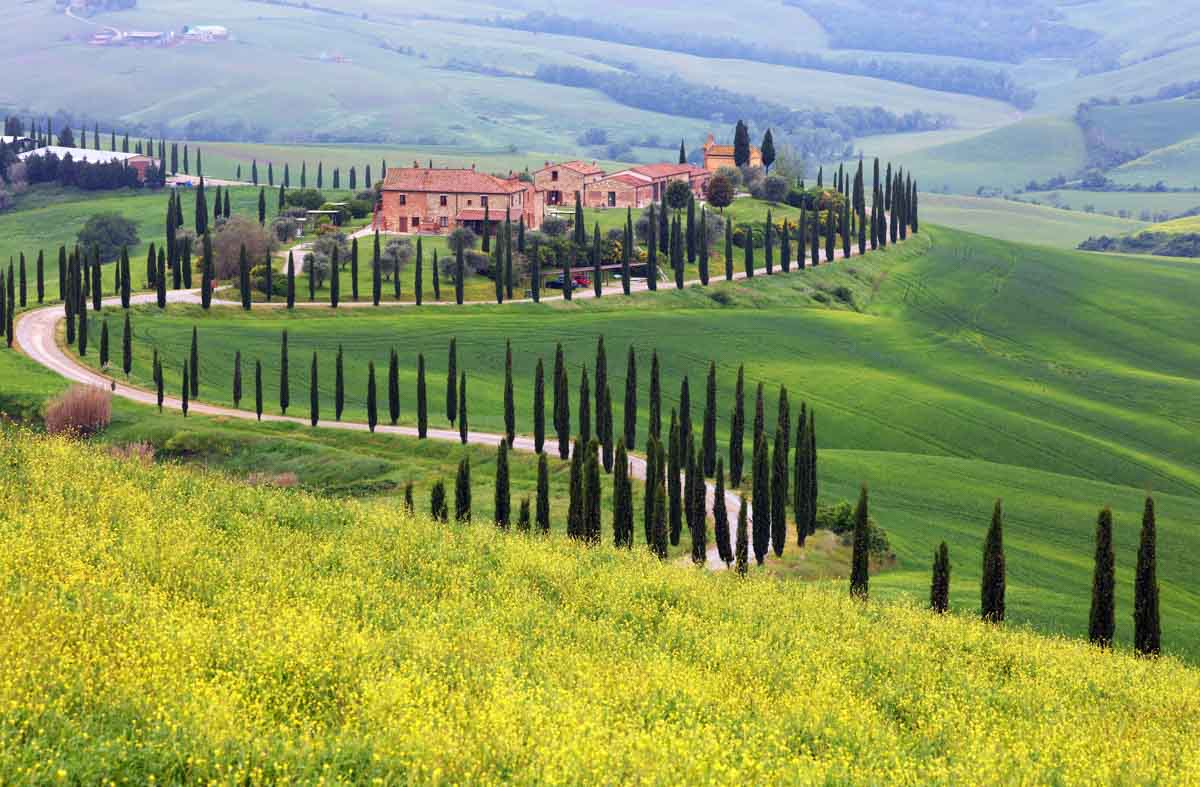
Some articles on this website contain affiliate links. This means that I may earn a small commission if you make a purchase through these links. As an Amazon Associate, I earn from qualifying purchases. Read the full disclosure here.
How to Use This Guide
This Tuscany guide is split into the following sections:
| Best Towns & Villages in Tuscany | Tuscan Cities |
| Beautiful Towns in Tuscany | |
| Best Villages in Tuscany | |
| How to Get to Tuscany | |
| The Best Time of Year to Visit Tuscany | |
| How To Travel Around Tuscany | Includes which Tuscan towns and villages you can reach by train and/or bus plus recommended day tours |
| The Best Towns to Stay in Tuscany | Are you wondering which is the perfect base in Tuscany? Check these recommendations. |
| Solo Travel in Tuscany |
To help you get a sense of where these beautiful Tuscan villages and towns are located, here’s a map for you to refer to. For an interactive map click here or on the image.
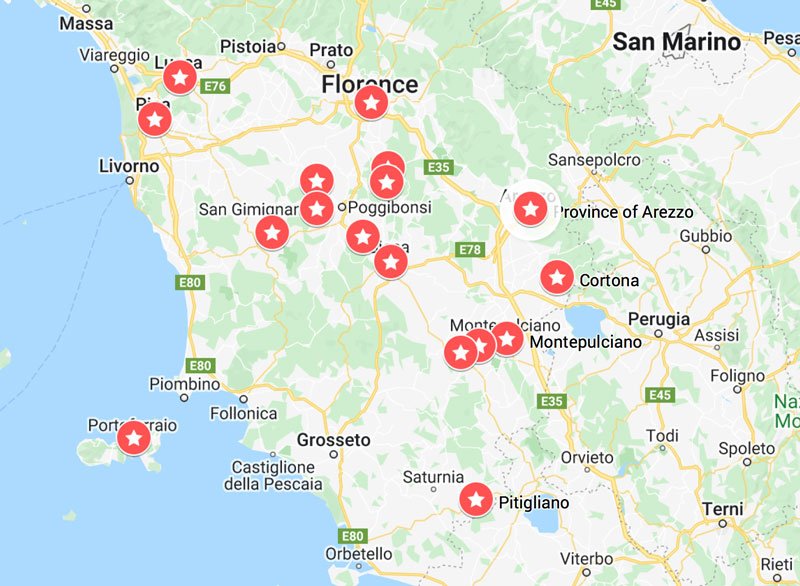
I’VE WRITTEN THIS ITALY SOLO TRAVEL GUIDE!
A 100+ page ebook to inspire and equip solo travellers with the confidence and knowledge to explore Italy independently
- Plan Your Trip – with curated itineraries, budgeting and how to get around
- Explore Awesome Destinations – guides to the must-see cities of Rome, Florence, Venice and Naples
- Stay Safe as a Solo Traveller – practical safety advice, empowering you to confidently navigate Italy and avoid common pitfalls
- Enjoy Eating Out in Italy – essential tried-and-tested solo dining tips
Tuscan Cities
Arezzo
By Bridget of The Flashpacker
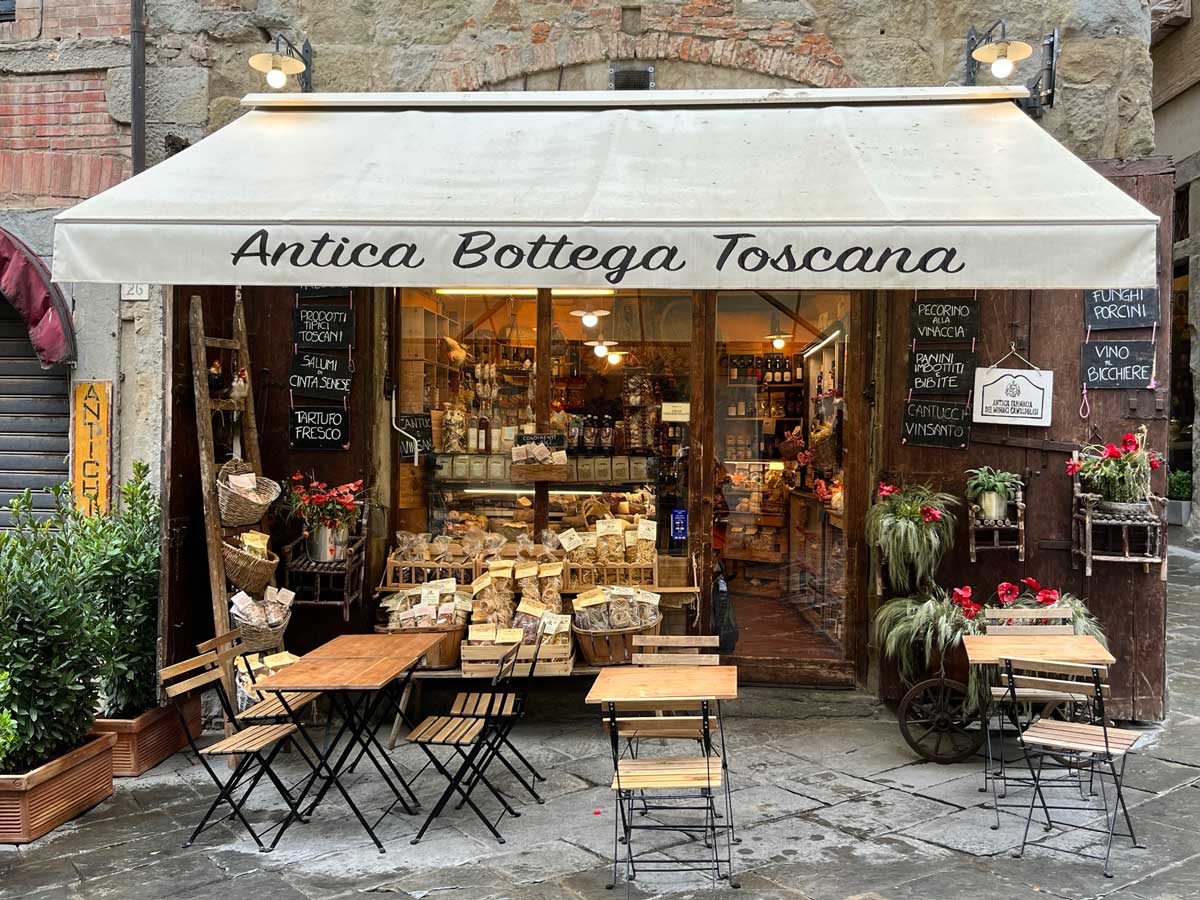
For a historic city in Tuscany that is off the well-trodden tourist trail, head to Arezzo.
This ancient Etruscan city is home to Piazza Grande, one of the most beautiful squares in Italy. Stop for a coffee in one of the bars that occupy the handsome loggia lining one side of the piazza.
Arezzo is a Mecca for art and antique lovers.
There are antique shops a-plenty and the biggest Antiques Fair in Italy takes place in Piazza Grande on the first weekend of every month.
Giorgio Vasari, the famous Italian artist lived in Arezzo and you can visit the palace that he bought in 1540 and decorated himself. The Church of San Francesco houses a Renaissance fresco cycle by Piero della Francesca depicting the Legend of the True Cross.
Arezzo is just one hour by train from Florence, making it an easy day trip.
Florence
By Darcy of Plan, Ready, Go
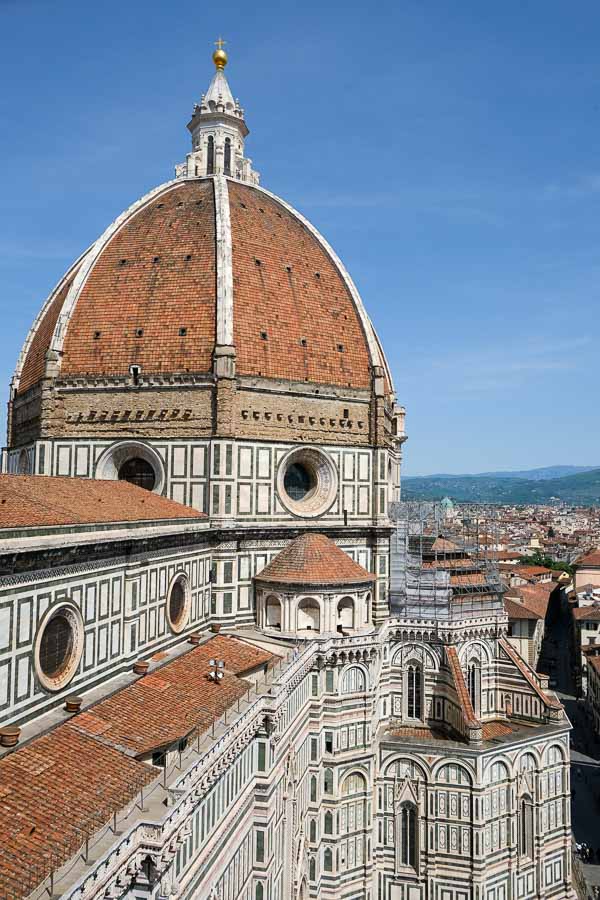
Best known for the red-tiled cathedral dome that rises over the city, Florence should not be missed on your visit to Tuscany. As the birthplace of the Renaissance, it’s a city steeped in history.
If you enjoy great views, climb to the top of the Duomo Dome or Giotto’s bell tower. If you are an art-lover, don’t miss the Galleria dell’Accademia (home of a clutch of the finest sculptures from Florence, including David by Michelangelo) or the beautiful Uffizi Galleries.
And of course, you’ll need to see the famous Ponte Vecchio bridge that spans the Arno River and the nearby Pitti Palace, one of many beautiful European palaces.
As well as the city’s famous landmarks, there are many Florence hidden gems you should make a point of seeing if you want to get off the beaten path. For example; the monastery cells decorated with Fra Angelico frescoes at San Marco and many small churches don’t get the same attention as the popular Duomo.
Stay in the historic centre of Florence to be in the middle of the action and ensure that everything you want to see is within walking distance.
Pisa
By Pamela of The Directionally Challenged Traveler
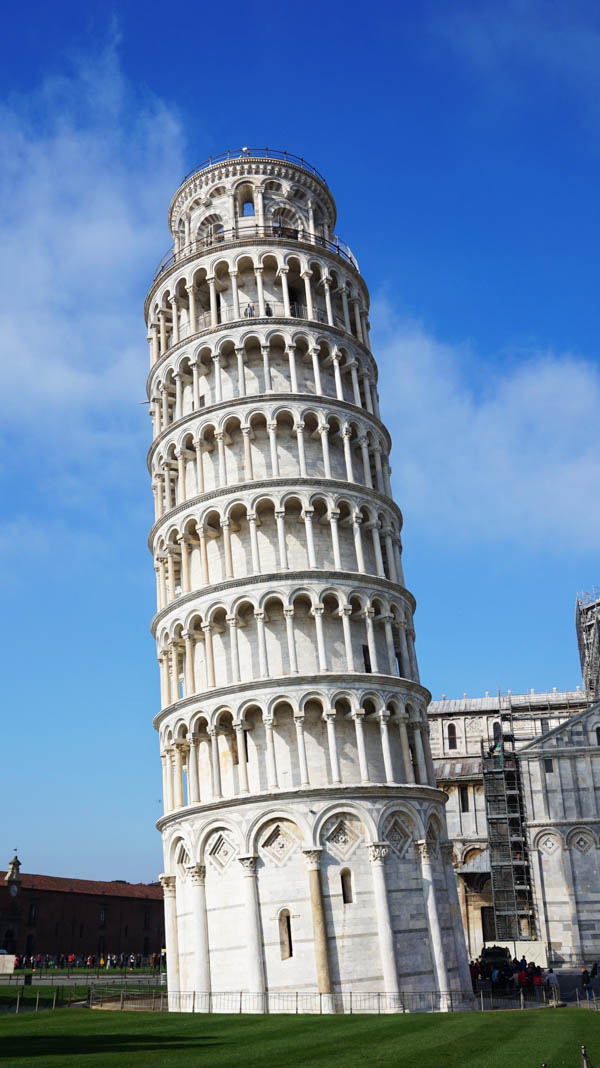
Pisa is one of the most visited and beautiful cities in Italy. While many go there simply to visit the torre pendente (Leaning Tower), there are plenty of other things to do and see.
Most people visit Pisa as a day trip from Florence. However, spending a night in Pisa ensures that you have time to see everything it has to offer.
Taking a silly selfie in front of the Leaning Tower is a rite of passage, but there are other buildings worth visiting. The Piazza dei Miracoli (where the Leaning Tower is located) is also home to Santa Maria dell’Assunta. The white marble exterior of the church is breathtaking.
Once you’re finished in the Piazza, it’s time to explore the town.
Borgo Street is one of the oldest streets in Pisa. Keep an eye out for the Ammannati House where Galileo Galilei was born in 1654.
For a bit of modern history, explore Tuttomondo. Representing peace and harmony for the world, this 180 square meters mural is located at San Antonio Abate church.
Sienna
By James Ian of Travel Collecting
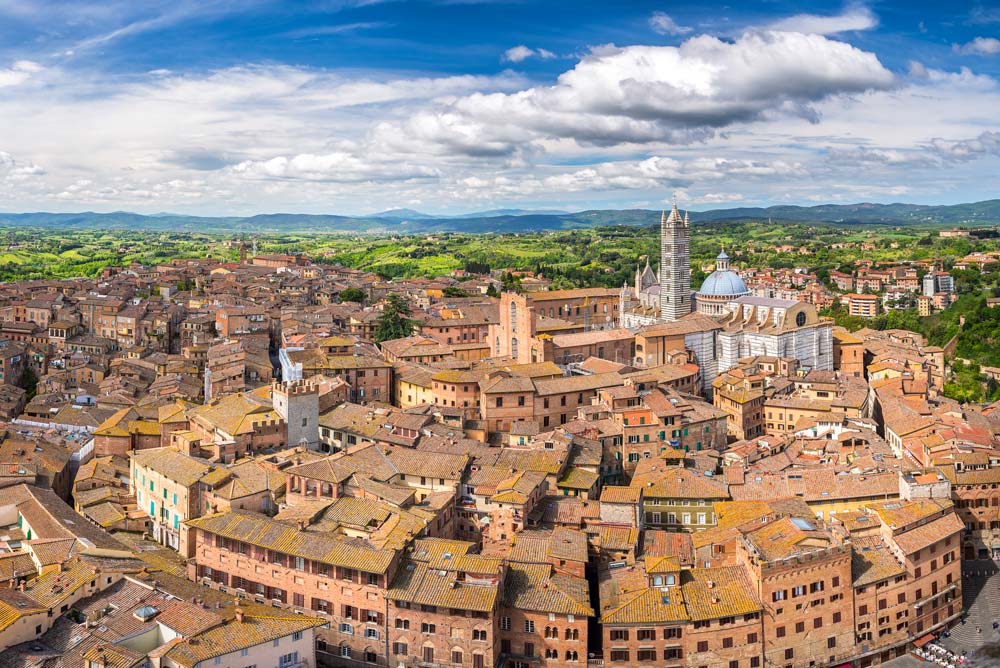
Siena has one of the most beautiful main squares in Italy, the shell-shaped Piazza del Campo.
Take a seat in one of the cafes on the edge of the piazza, watch the people and soak in the architecture over a cup of coffee or a glass of wine. If you are there in July or August, you may also witness the Palio de Siena, a horse race around the edge of the piazza.
There are many more things to see in Siena.
The Duomo di Siena (cathedral) is a medieval masterpiece. It is built of striped black/ dark green and white marble inside and out, black and white being the colours of the city.
Try to get there early to avoid long lines (or get your tickets online), then climb to the top of the dome inside so you can look down and see the mosaic floor clearly. Be sure to visit the cathedral’s private art museum, the Museo dell’Opera Metropolitana, and go to the Facciatone, a walkway on its roof with stunning views over the city.
The other famous viewpoint in the city is the Torre (Tower) del Mangia. Right on Piazza del Campo, the 102-meter-tall, 14th-century tower offers incredible views of the square, the cathedral and the rest of the city.
Many of the walls are stylishly unfinished and decorated in an elegant rustic chic style you will love. Plus, it is right in the city centre.
No matter what you do, or how long you stay, you will love Siena.
Charming Towns in Tuscany
Certaldo
By Joanna of The World in My Pocket
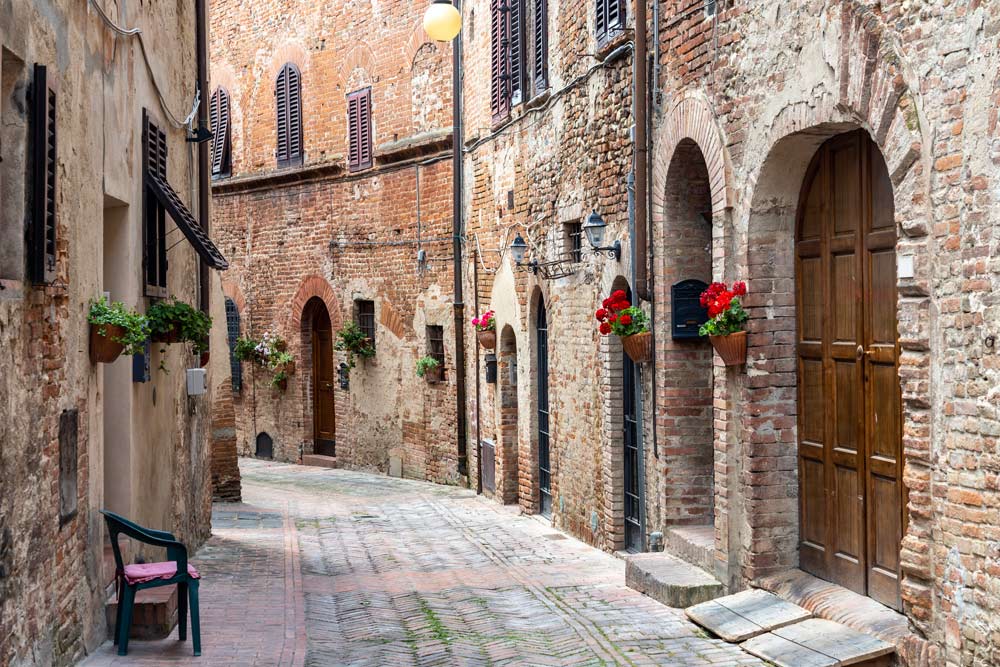
Certaldo is a beautiful, off-the-beaten-path town in Tuscany.
The town is divided between the old and the new part, the former located on top of a hill, easily reachable by a funicular. Walking along the streets of Certaldo’s old town feels like you have been transported to the medieval age.
Within Italy, Certaldo is famous as Bocaccio’s home.
The main street in town, Via Boccaccio, leads to the Palazzo Pretorio, the former residence of the vicars of power. The palace is decorated with coats of arms that commemorate the vicars sent from Florence.
Along the same road, you can visit Giovanni Boccaccio’s home, where you can see some rare editions of his work.
There are many hidden gems in Certaldo, such as the nails museum or the archery headquarters, hidden in a cellar.
If you visit Certaldo in June, make sure you plan your visit at the same time as the Dinner with Mr Boccaccio event, when one street of the town transforms into an outdoors medieval dining place. Attendees dress up as medieval characters and join in an interactive dinner and theatre performance.
Cortona
By Renee of Dream Plan Experience
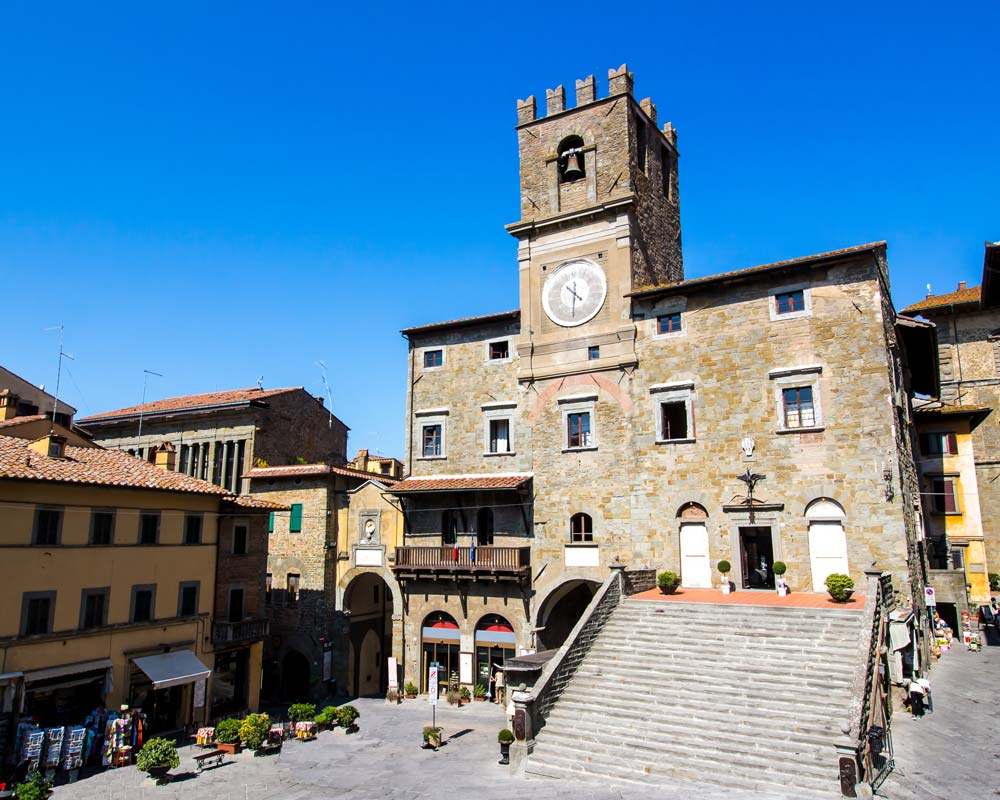
The beautiful hilltop town of Cortona was put on the map with the release of Under the Tuscan Sun, first the book by Francis Mayes, and then the movie. It sits in the eastern part of Tuscany about an hour’s drive from Florence.
This stone-clad town has a rich history dating back to 400-600 BC. But it was in the 13th century that the town started to flourish.
The heart of this charming town is the main square, Piazza della Repubblica, featuring many historical buildings from the 13th century. A well-preserved town hall, clock tower and former palace are just some of the significant landmarks you will find.
In this lively piazza, locals go about their daily business, catching up with one another and stopping in their favourite shops and cafés. Try to visit on market day, Saturday, and watch the town really come alive.
There is so much to see and do in Cortona, from its many museums to its countless churches.
Grab a gelato from the delicious Gelateria Snoopy and simply get lost in Cortona’s endless narrow alleyways, or vicoli as Italians call them. Finally, take in those epic Tuscan countryside views.
Greve
By Or of My Path in the World
Located along the scenic Chiantigiana road, Greve in Chianti is one of the most charming towns in Tuscany. Its history dates back many centuries, with the entire area settled since ancient times.
Start your visit to Greve in the uniquely shaped main square, Piazza Matteotti. Be sure to visit it on a Saturday when the local weekly market takes place and the entire square is filled with stalls selling flowers, cheeses, household goods and more.
Continue by visiting Greve’s main landmarks and museums: Basilica of Santa Croce, Wine Museum, and Museum of Sacred Art. Wander through the town’s streets, devour an Italian meal in Ristorante Enoteca Fuoripiazza or Ristorante la Bottega del Moro, and have a wine tasting and tour in nearby wineries like Azienda Agricola Montefioralle and Montecalvi.
Last but not least, Greve also hosts incredible annual festivals, including an antique fair in Easter, a flower festival in May, and the Chianti Classico wine festival in September.
Lucca
By Katy of Untold Morsels
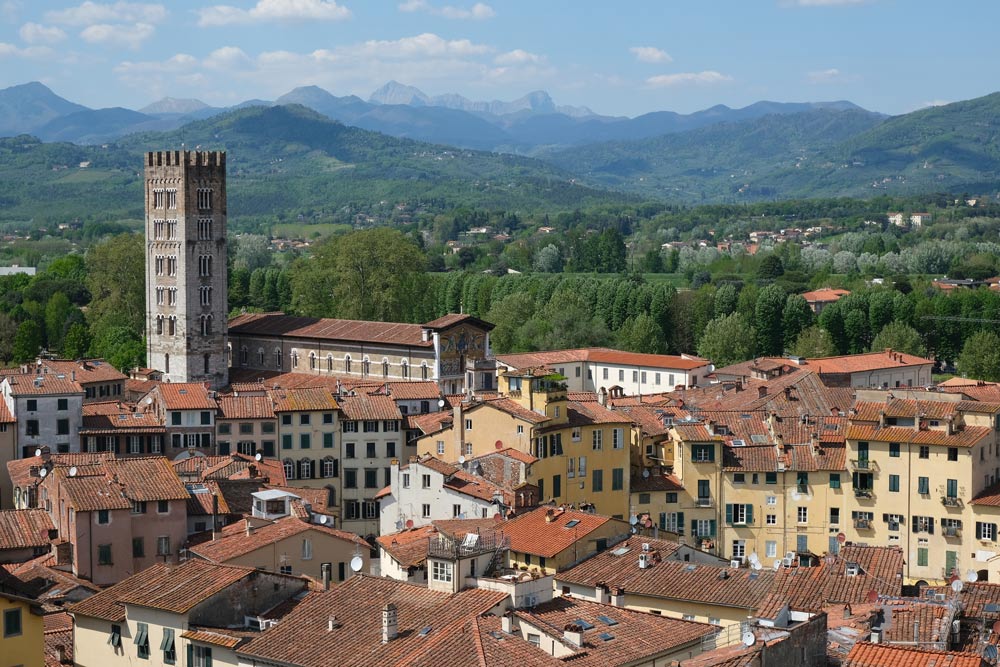
Lovely Lucca is Tuscany’s unsung heroine. Overshadowed by her popular neighbours, the city quietly goes about its business but yields many treasures if you’re prepared to take the time to visit.
Lucca is a walled city with a charming centro storico but it is the walls themselves that are one of its major attractions. Converted into a park in the 18th century, you can walk or hire bikes to cycle around the town, taking in views of the city and surrounding countryside.
The city is also known for its soaring medieval towers, the most famous of which is Torre Guinigi, easily recognised by the tree on its rooftop.
Lucca is also a city of charming piazzas and notable churches. The Piazza dell’ Anfiteatro, is on the site of a Roman amphitheatre and the magnificent Chiesa di San Michele in Foro gazes down on the square that takes its name.
You can easily spend a couple of days exploring Lucca but it’s also a great base to reach Pisa, Florence, the coast and the Garfagnana hills.
Montepulciano
By Lori of Travelinmad
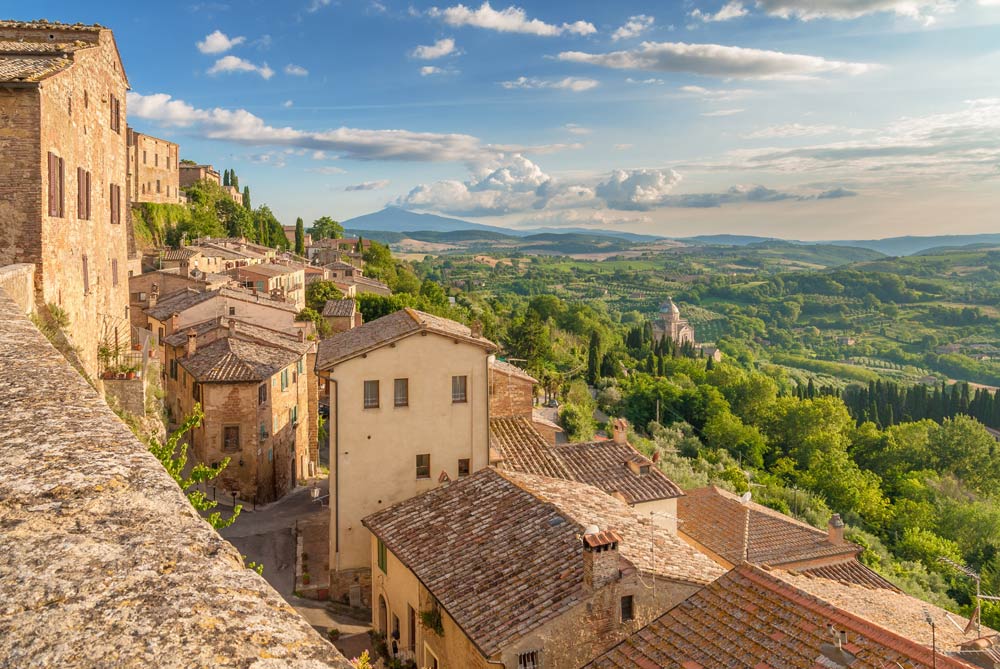
When travelling in Italy, be sure to include a visit to one of the most beautiful towns in Tuscany, the medieval hilltop town of Montepulciano.
Located in the scenic Val d’Orcia region of southern Tuscany, the cobblestoned town is easily walkable with sturdy, comfortable shoes. Montepulciano is simple to get to from both Florence and Siena and makes a perfect Tuscany road trip destination.
The town of Montepulciano is surrounded by classic Tuscan scenery and vineyards that produce some of the best wines in Italy, the most famous of which is Nobile di Montepulciano. As you pass historic buildings, restaurants, boutique shops and wine shops, you’ll have panoramic views of the lush valley below.
Head to the Piazza Grande in the centre of town where locals congregate in the early evening and you might catch a local festival. Have dinner at Ristorante la Grotta near the famous Renaissance Church of San Biagio overlooking the countryside.
Stay here with a rental car and you can easily day trip to Pienza, Montalcino and Siena.
Panzano
By Cecily of Groovy Mashed Potatoes
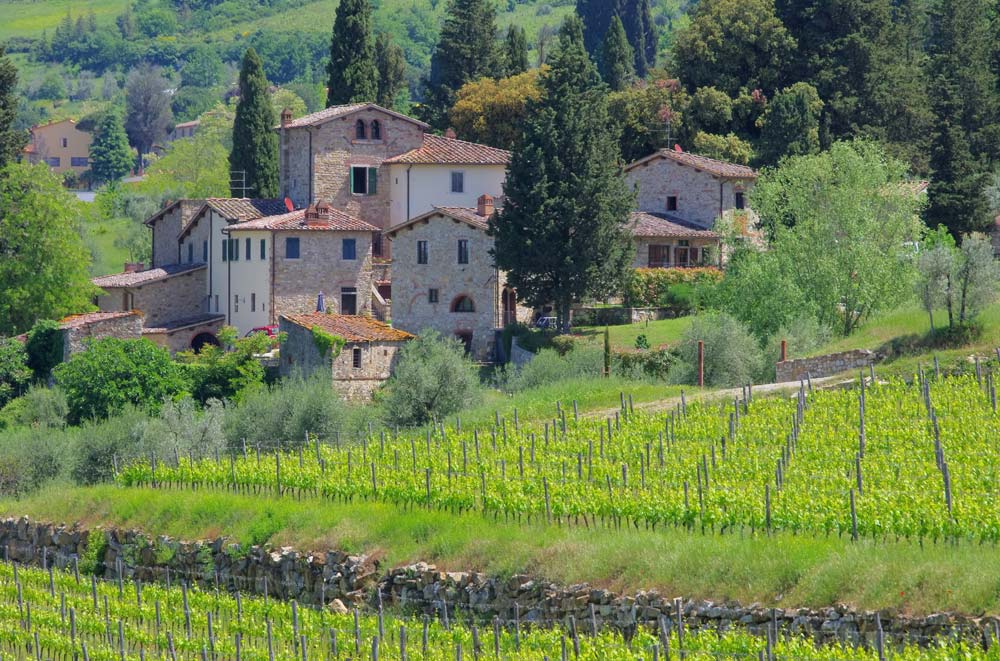
Unwind in Panzano, a romantic hilltop town in the Chianti Classico wine region. This charming town in Tuscany is less than an hour’s drive from Florence, making it a great addition to your Italy itinerary.
One of the best ways to experience Panzano is by staying in an authentic farmhouse.
Podere Felceto is a family-owned organic olive oil farm, which hosts guests in its beautiful traditional stone villa. A highlight is spending time at the outdoor pool while taking in the serene surroundings.
Panzano may be small but has many wine-tasting opportunities and delicious restaurants. During the daytime organise a wine tour at one of the surrounding wineries, like Castello di Verrazzano.
For an intimate dinner, eat at Ristorante Oltre Il Giardino, a cosy restaurant known for its meat and pasta dishes.
For an exciting, lively experience, book a dinner at Officina Della Bistecca, owned by the world-famous butcher, Dario Cecchini. The communal dining room, located in the back of his butcher shop up a set of stairs, is where you will be served five mouth-watering courses of steak.
Pienza
By Jürgen and Martina of Places of Juma
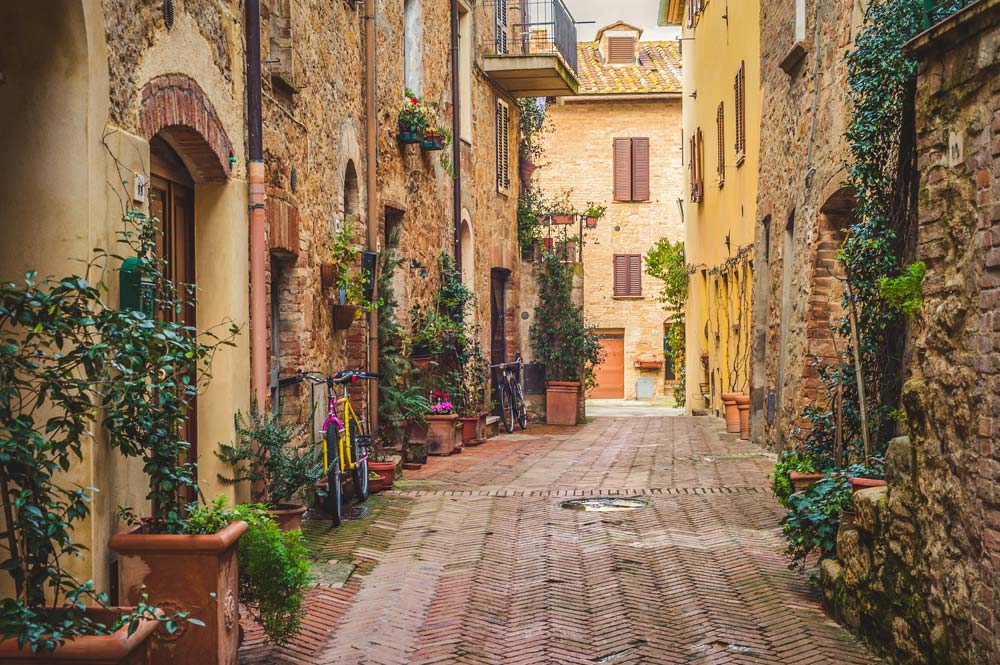
Pienza is one of the most beautiful towns in Tuscany to visit. Its old town is considered a perfect Renaissance city, surrounded by rolling fields, dreamlike viewpoints and picturesque cypress avenues.
Since 1996, Pienza’s historic centre has been a UNESCO World Heritage site.
Walk through the city to discover countless pretty squares, historical buildings and museums. Don’t miss famous landmarks such as the imposing town hall, the beautiful Palace Palazzo Piccolomini and the Cathedral of Santa Maria Assunta.
Take a break from sightseeing at one of Pienza’s many good restaurants. You will find them directly at the main square, Piazza Pio II, but also tucked away on the town’s romantic side streets. Pienza is famous for its delicious Pecorino cheese.
Pitigliano
By Lisa of Travel Connect Experience
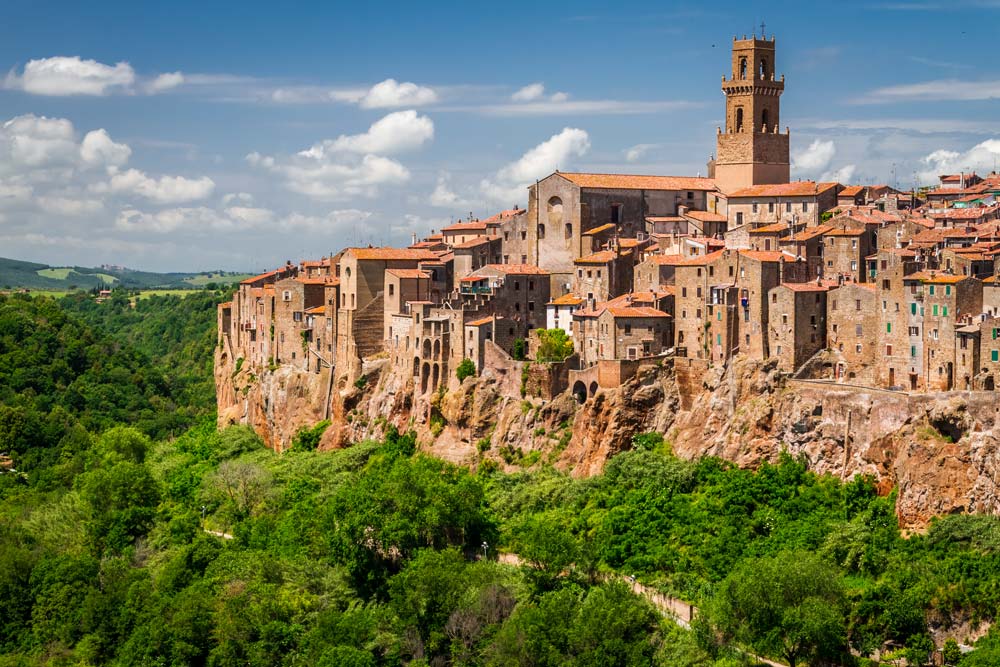
Almost halfway between Rome and Florence, lies the picturesque village of Pitigliano, perched on a flat cliff of tufa rock, surrounded by lush and dense forests.
This volcanic landscape is typical of the Tuscia region of central Italy. This region witnessed the flourishing of the Etruscan civilization, from which the Romans derived much in terms of culture, religion, and engineering.
The architecture of Pitigliano as we see it today appears medieval. But if you look closer you can see traces of a much more ancient past, including stores and houses from the pre-Roman era.
The historical centre can be visited in a few hours.
Starting from Piazza Della Repubblica, first visit the Fountain of the Seven Spouts, built into the structure of the ancient aqueduct with 14 arches. Next is the Orsini Fortress with the Archaeological Museum, and Via Roma with the stores of artisans. Eventually, you will reach Little Jerusalem, one of the oldest Jewish neighbourhoods in Europe.
If you love walking in nature you can venture into some of the 21 “Vie Cave” that surround Pitigliano. These are ancient paths carved into the tufa walls and crossing the necropolis of the Etruscan period that hide mysterious archaeological sites like the Tomb of Ildebranda.
Portoferraio
By Emma of Emma’s Roadmap
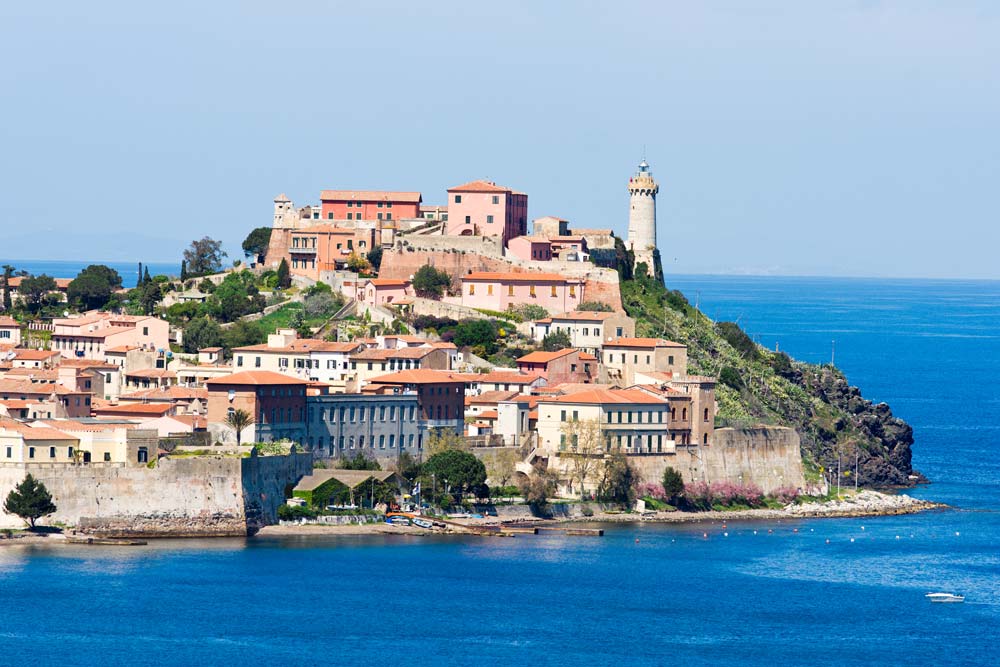
Portoferraio is one of the most charming harbour towns in Tuscany and is the capital of the island Elba. It is the perfect place to explore more of Italy’s wonderful coast.
The name of Portoferraio refers to its history as a trading harbour for iron. Literally, Portoferraio means “Iron Harbour”.
However, these days, Portoferraio is known for many other things.
Its most famous inhabitant was Napoleon Bonaparte, who was banished to the island in 1814 and lived there for almost a year. This is one of the reasons why Portoferraio attracts tourists.
Villa dei Mulini, one of Napoleon’s previous houses, is a major attraction in Portoferraio. It is also a great way to learn about the history of Napoleon and how he used to live.
Visiting Martello Tower is another popular activity in this town. This tower was originally built as part of the island’s defence infrastructure and was later turned into a prison. From the top of this tower, you’ll have an amazing view of the bay of Portoferraio.
Before you leave Elba, don’t forget to taste the delicious local cuisine.
Volterra
By Kate of Our Escape Clause
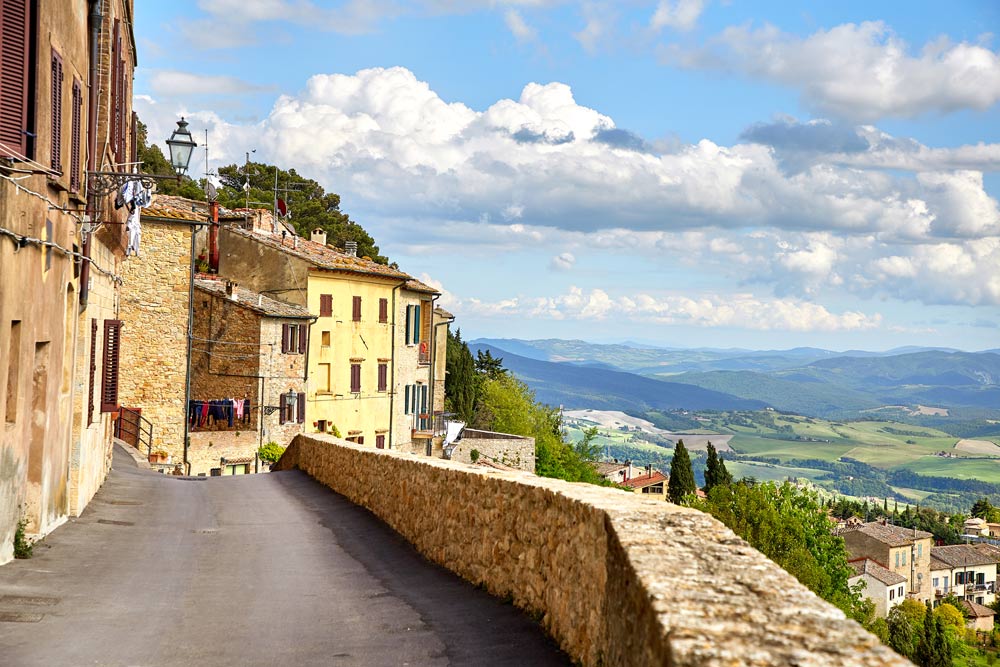
Perched high on a hilltop and overlooking the rolling countryside, Volterra is an idyllic Tuscan town.
Less crowded than popular spots like Pisa or Lucca, and dating back to the Etruscans, Volterra offers visitors a chance to discover a (slightly) quieter side to Tuscany, while still enjoying all the beauty and history that the region offers.
The best things to do in Volterra include visiting the Piazza dei Priori, as well as the Palazzo dei Priori right on the piazza (be sure to climb the tower for amazing views of Tuscany). You can also explore the remains of the Roman theatre, shop for alabaster and visit the Etruscan Museum.
Younger visitors may also recognise the town of Volterra for a different reason: Volterra was the setting of a small section of the Twilight book and movie series, specifically the climax of New Moon. The movies didn’t film in town, though they did film in another beautiful town in Tuscany: Montepulciano.
Best Villages in Tuscany
Monteriggioni
By Casandra of Karpiak Caravan Adventure Family Travel
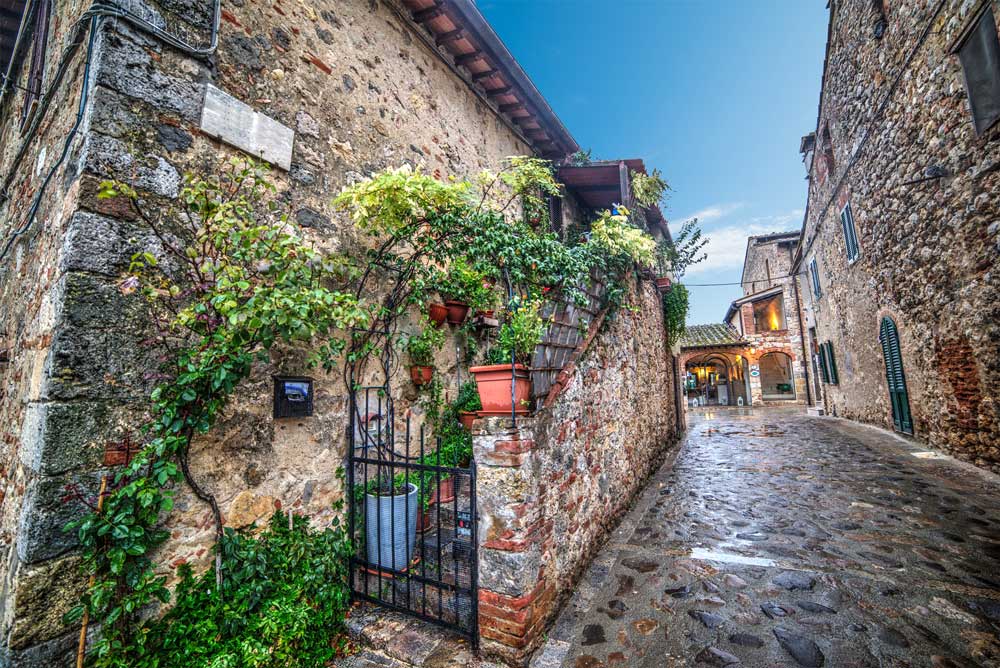
The charming Tuscan village of Monteriggioni is located on the outskirts of Siena and offers gorgeous views of the surrounding Chianti region. This walled medieval village, sitting atop the Tuscan hillside, has towers that can be seen from miles away.
Monteriggioni’s walls are still intact and you can walk along the top of certain sections. Tickets cost 4 Euros to walk on these walkways, well worth it to see the famous 360-degree views of Tuscany.
The Armoury Museum is a fun experience because you get to try on some of the armour and try to swing a sword that weighs 10kg. There are reproductions of medieval and Renaissance weapons on display, as well as a souvenir shop.
The best time to visit Monteriggioni is during the Medieval Festival at the beginning of July. It is truly an event to see as the locals dress up in their best medieval outfits. It is one of the most popular events in all of Tuscany.
San Gimignano
By Erki of GENEM Travels
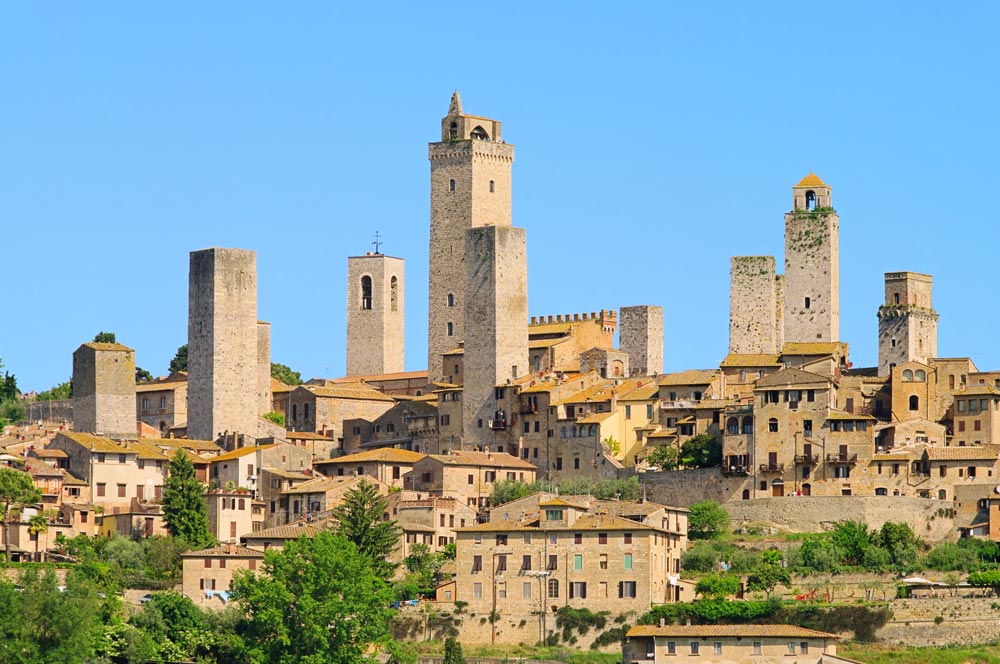
San Gimignano is a charming village in Tuscany, featuring medieval architecture, impressive towers and magnificent views over the rolling landscape. Well-preserved and maintained, it is relatively small and is walkable within one day.
It’s a typical Tuscan village with ancient stone buildings, surrounded by scenic fields of olives and grapes. When strolling around its narrow streets, stop to admire its several churches, viewpoints out of town and the main square.
San Gimignano is also known for its rich food and wine culture. Try local food and drinks at one of the village’s restaurants and shops.
But San Gimignano is most famous for its towers, which have earned it the name Medieval Manhattan. Of its 72 towers, 14 have survived. The most prominent tower, Torre Grossa, reaches up to 54 meters and is open to visitors.
San Quirico d’Orcia
By Denise of Chef Denise
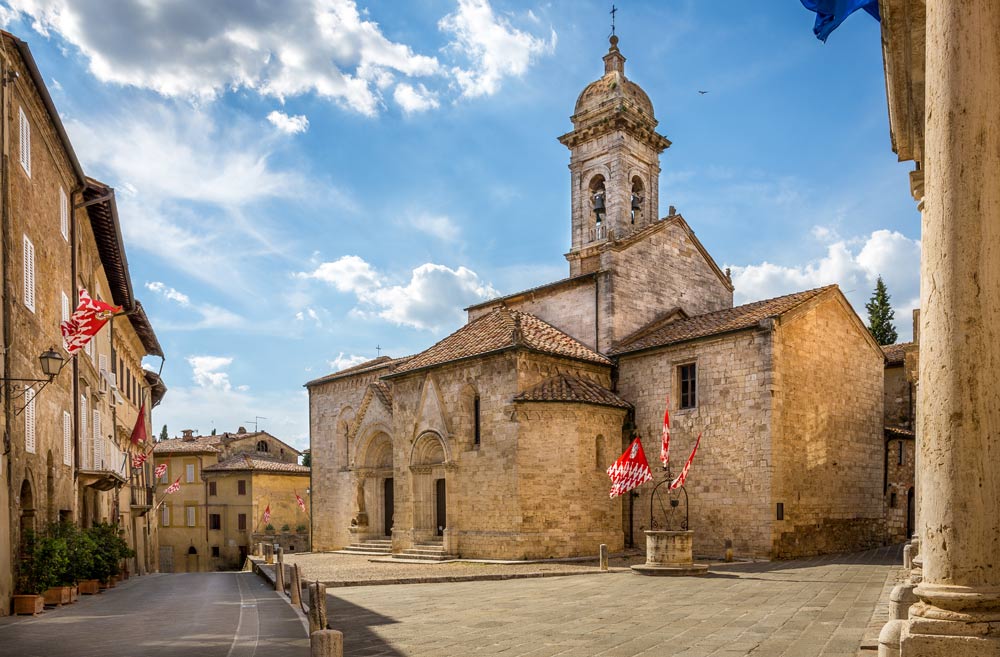
You may never have heard of the tiny Tuscan village of San Quirico d’Orcia, but you’ve probably seen photos of its Chapel of Madonna of Vitaleta, or its famous cypress trees standing tall on rolling green hills.
Located in the picturesque southern region of Tuscany called Val d’Orcia, San Quirico d’Orcia is midway between the two larger villages of Pienza and Montalcino. It is less than an hour’s drive to Sienna.
The charming walled village of San Quirico d’Orcia can easily be explored in a day.
One main street runs through the centre of this historic village where you’ll see the Collegiata di San Quirico and the Church of Santa Maria Assunta. The church’s rose garden leads into the immaculately manicured Horti Leonini Gardens, which represent a typical Italian-style garden.
When you’ve exhausted the town, admire the surrounding landscape. Hike up to the chapel or through the beautiful countryside.
Staying at the stone farmhouse, Il Rigo Agrotourism, is an ideal way to explore this area and its nearby villages and to enjoy delicious regional Italian dishes. Il Rigo provides an organic breakfast daily and offers a four-course dinner at a bargain price.
How To Get To Tuscany
By plane
There are two international airports in Tuscany: Galileo Galilei International Airport in Pisa and the smaller Amerigo Vespucci Airport, also known as Peretola, in Florence.
Alternatively, fly to Rome and continue your journey to Tuscany by train (approximately 90m minutes), bus or rental car.
By train
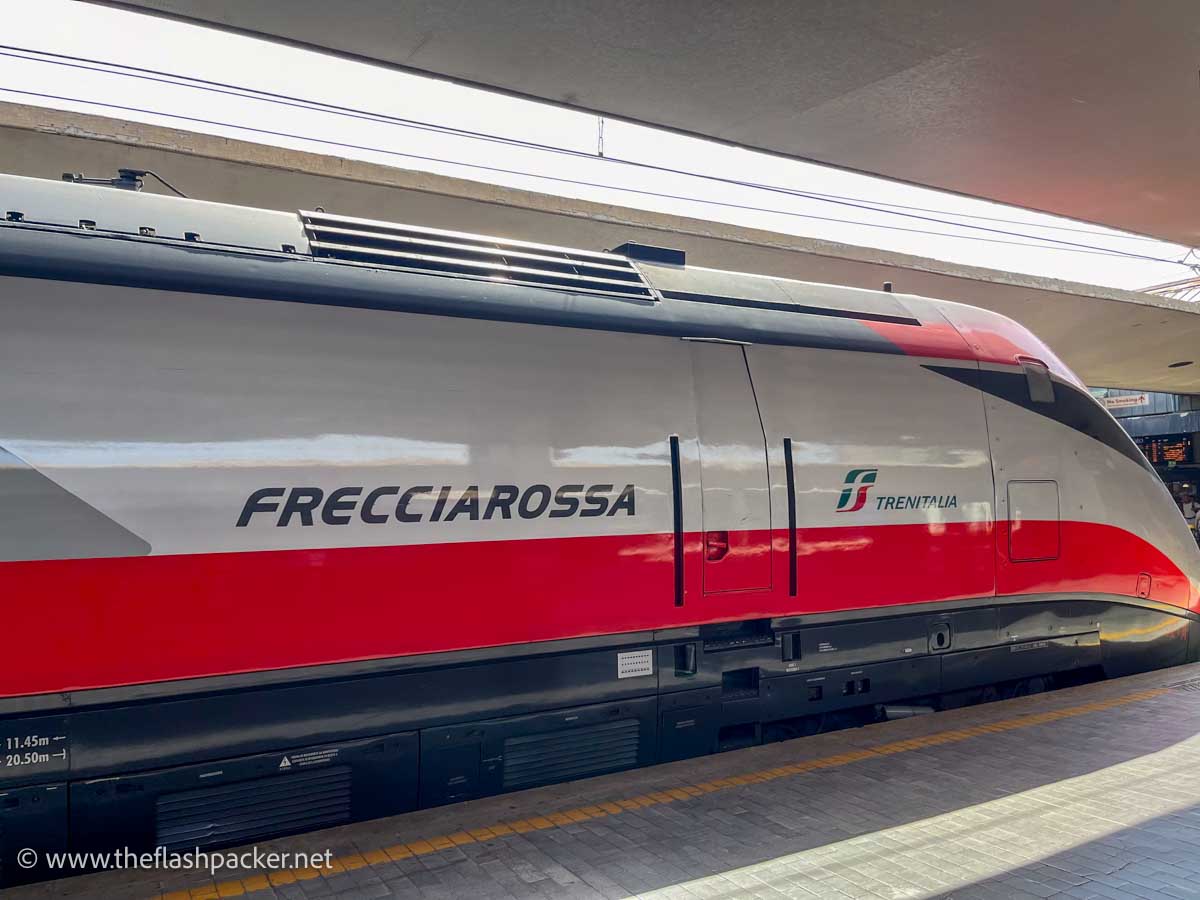
As the Italian railway system is connected with other European countries, it is easy to reach Tuscany from cities in Europe and Italy.
The main railway hub in Tuscany is Florence’s Santa Maria Novella (SMN) station. Direct international trains arrive in Florence from Paris, Brussels, Amsterdam, Basel, Munich, and other European cities. Siena railway station is another important Tuscany transport hub.
Within Italy, there are fast connections from major cities, including Naples, Rome, Milan, Bologna, Pisa, Verona, Venice, Genoa and Turin.
There is a choice of two train companies: Trenitalia, the national operator and the privately-run Italo. To search across both providers, I use Omio.
There is a small surcharge to book via this platform but it is easy to use. Alternatively, use it simply as a train search engine and then head to the operator’s website if you want to book tickets in advance.
If Tuscany is part of a multicountry train itinerary, you may save money and hassle by using an Interrail pass. If Italy is your sole destination, an Interrail or Eurail Pass may not be your best option.
When to Visit Tuscany
The best time to visit Tuscany is mid-to-late spring (April and May) or early autumn (September and October) when the landscape is at its best and temperatures are comfortable.
If possible, avoid visiting Tuscany in the summer months when temperatures hit the high 80s and 90s.
How To Travel Around Tuscany
In terms of convenience, flexibility and accessibility, exploring Tuscany by car is hard to beat.
But if you can’t or won’t drive, Tuscany’s public transport is affordable, reaches the region’s main attractions and is user-friendly. However, only the bigger towns in Tuscany have train stations and although bus services are available, they tend to be infrequent.
If you are relying on public transport, stay in one of the larger towns in Tuscany. You can then use this as a base to visit the smaller Tuscan villages and towns on day trips, either independently or on an organised tour.
Cities and towns in Tuscany that have a train station
These Tuscan towns have a railway station:
- Florence
- Sienna
- Pisa
- Lucca
- Certaldo
- Viareggio
Towns and villages in Tuscany that have a train station within a short bus journey
Montepulciano
The nearest train station is half an hour away at Chiusi. From the bus stop outside Chiusi’s rail station, there are buses to Montepulciano.
San Gimignano
Poggibonsi, 30-40 mins away, is the nearest train station to San Gimignano. A frequent bus service connects the two.
Volterra
Take a train to Colle di Val d’Elsa, Pontedera or Cecina and then take the bus to Volterra.
Also, bear in mind the landscape.
Many towns and villages in Tuscany are perched on a hilltop. Even if they are served by a railway station, you may need to hop on a local bus to take you from the station to the town itself. Otherwise, be prepared to exercise those calf muscles with a steep uphill walk.
Visiting Tuscan towns and villages on a guided day tour
If you are not keen on taking your chances with the Italian roads, trains and buses, why not book a day trip from Florence, Siena or Rome?
My go-to platform for sourcing and booking day trips is GetYourGuide, which usually offers free cancellation up to 24 hours before your activity. Here are a few day trips that should fit the bill:
FROM FLORENCE
Tuscany Highlights
Discover Siena, San Gimignano and Pisa on this full-day excursion. It includes lunch on a wine estate and wine tasting.
>>> CLICK HERE TO FIND OUT MORE
Day trip to Pisa and Lucca
Another highly-rated experience that takes you on guided tours of two wonderful Tuscan cities
>>> CLICK HERE TO FIND OUT MORE
FROM SIENA
Pienza and Montepulciano Wine Tour
Taste the food and wines of Tuscany on this 10-hour tour of Montalcino, Pienza and Montepulciano.
>>> CLICK HERE TO BOOK
Best Base for Exploring Tuscany
My top tip is to pick a base and stick with it. If you don’t have a car, focus on places within striking distance of a train station.
In (very) general terms, base yourself in Florence if it is your first time in Tuscany. Florence is also an excellent base for visiting towns and villages in northern Tuscany, including Lucca and Arezzo.
If you are a repeat visitor or wish to explore Southern Tuscany, Siena is an excellent base. For example; from here, you can visit Pienza and Montepulciano.
Other good alternatives are Pisa, Lucca or Viareggio.
Of course, if you have a week or more in Tuscany, you can divide your time between two (or more) bases.
Solo Travel in Tuscany
Italy is a great choice for those travelling alone in Europe, especially first-time solo travellers.
The country has a well-developed tourist infrastructure. Thanks to a well-worn tourist trail, you won’t have to worry about being the only foreigner in a town and it’s easy to strike up friendships with fellow travellers.
Safety is an important consideration for solo travellers and towns in Tuscany are likely to be no more dangerous than those in Europe or North America.
Finally, there is comfort and reassurance in familiarity. Without being aware of it, you have likely become immersed in Italy’s food and culture, from its iconic paintings to pasta and pizza. Ordering a coffee in an Italian bar should come as second nature.
READ THIS NEXT: Best Solo Travel Destinations in Italy
Which of These Beautiful Towns and Villages in Tuscany Will You Visit?
One of the things that Italy is famous for is its medieval towns and villages. Thanks to my fellow travel writers, you now have a selection of gorgeous towns and villages in Tuscany to visit.
Whether you picture yourself drinking an espresso or a local Chianti in a picturesque piazza or visiting Renaissance churches, the choice is yours. The best thing is that when visiting towns and villages in Tuscany, there’s no such thing as a bad choice.
Buon viaggio!

About Bridget
Bridget Coleman has been a passionate traveller for more than 30 years. She has visited 70+ countries, most as a solo traveller.
Articles on this site reflect her first-hand experiences.
To get in touch, email her at hello@theflashpacker.net or follow her on social media.

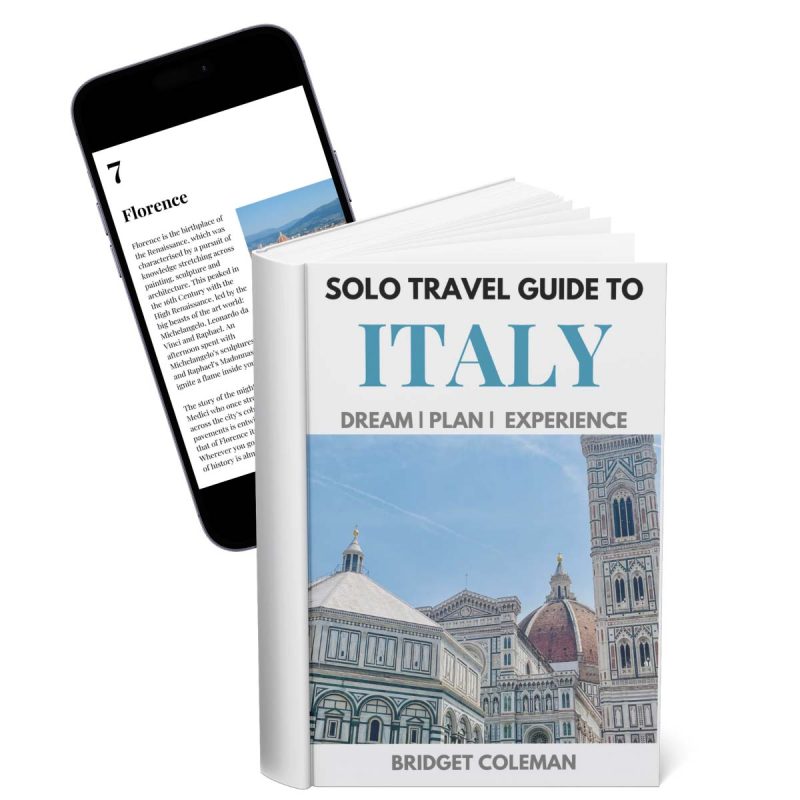
Love your comments and advice! Going to Tuscany next year and starting to plan my trip! Finding your info to be a great tool on planning my trip! Thanks so much!
So pleased that you’ve found the article helpful! I’m also hoping to return to Tuscany